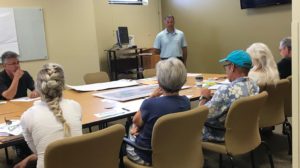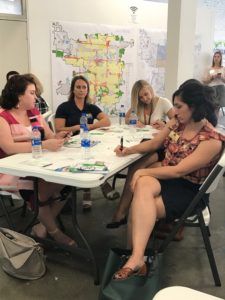
Springfield’s new Comprehensive Plan, Forward SGF: What the future holds in store for the development and expansion of the city
Community, News October 11, 2019, Comments Off 242In June of 2019, the City of Springfield unveiled a new 20-year Comprehensive Plan that will guide the city until 2040 called Forward SGF. Forward SGF promises a variety of changes in how the city will look and operate.
Randall Whitman is the Principal Planner on the Planning & Neighborhoods Team for the City of Springfield.
What is a Comprehensive Plan?
Whitman described a Comprehensive Plan as “a visionary blueprint or guidebook for the physical development of the city… It helps combine and integrate a variety of elements and components that the city has authority over, whether that be land use, economic development, housing, neighborhood development, transportation, mobility, walkability, all sorts of capital improvements and infrastructure.”
State statute dictates that all cities must develop Comprehensive Plans that cover 20-year periods. In practice, most Comprehensive Plans cover 5-year segments and are reviewed every 5 years. Springfield’s last Comprehensive Plan was developed in 2000 and was named Vision 2020.
“As the name implies,” joked Whitman, “it will expire next year, so we need to get a new plan in place.”
The goal of Forward SGF is to raise quality of life. For Whitman, the entire planning process is all about the citizens and what they get out of living in Springfield. Whitman wants citizens to know that their city government and public service workers genuinely care about them and every aspect of their lives, from their economic success to their safety at home.
The new plan is yet to be written. The city’s goal in drafting the plan is for it to come directly from citizens.

(Photo via Randall Whitman)
“Our community will decide what’s most important,” said Whitman. “We’ve already engaged about 600 people at workshops where we’ve asked them ‘what are your top priorities for the community, what are your top issues, your top concerns?’ That’s where the plan really begins to start, is by isolating the issues that the community wants you to focus on.”
This feedback that comes directly from community engagement is combined with data, statistics, and demographics to determine how the city will allocate funding, effort, and other resources moving ahead. “The policies that we create, the guidelines, the recommendations, all that comes straight from the people,” said Whitman.
“We’re in the discovery phase,” he laughed, continuing. “We’re out asking questions and identifying priorities of the people, the citizens, who will be affected most by this.”
To make your voice heard, visit one of the upcoming engagement workshops. A full schedule can be found at http://www.forwardsgf.com/pages/get-involved—springfield.
What will the new plan do?
City utilities and public health
According to Whitman, Comprehensive Plans are what allow cities to develop legislation and zoning requirements to expand and build stronger communities. Beyond just looking at economic and land development, Comprehensive Plans also entail city utilities such as gas, water, electricity and, for Springfield, fiber-optics.
Public health is an area that is not explicitly covered in a chapter in most Comprehensive Plan but is a significant factor for Whitman and the team.
“A healthy populous comes from people who are active and who are engaged. You have to look at the lifestyles people have, if they’re socially active and engaged in activities; whether that be they go to ballgames, participate at entertainment venues, or are active in collaborations with different groups like church or academic things,” explained Whitman.
A big part of Forward SGF will focus on walkability. “We want to make sure our sidewalks are connected, and the land uses of areas adjacent to our public transportation are supportive of one another and integrated,” Whitman said.
Expanding city limits
Forward SGF may see Springfield extending its jurisdiction. The city is considering the question of whether or not to annex property outside city lines to expand city limits.
Whitman explained, “Our urban service area is much larger than the city’s 84 square-miles. It may not be incorporated areas, but we have an obligation to surrounding urban areas that depend on Springfield as the urban hub of the Ozarks… We’re identifying areas where we need to do more planning, whether that be neighborhoods, corridors, even up-and-coming areas like Galloway, for instance.”
Whitman called Springfield an “urban center” for South-west Missouri. Springfield is the third-largest city in the state and a major employer, with several universities and major healthcare centers. Annexing territory would come with new costs to the city, but also new opportunities for potential revenue and development, which Whitman calls “growth-management.” Extending Springfield’s territory rather than focusing resources on areas already integrated could save the city money in the long run.

Making plans (Photo via Randall Whitman)
Stimulating the economy
“Economic development is many things,” said Whitman. “It’s how we invest in our own infrastructure, but it’s also how we support industry: the roads and the infrastructure that goes into creating lots in an industrial park or how we maintain right-of-ways in a marketplace.”
Whitman called sales tax the “lifeblood of the city.” He mentioned competing with online realtors like Amazon, which “steal” tax revenue that the city would receive if people bought more goods in person. Whitman’s solution is to create an experience while shopping. Places like Battlefield Mall and downtown need to become more attractive alternatives to sitting at home and ordering online in order to generate more sales tax revenue for the city to fund its utilities expansions.
“In terms of job creation, the city needs to ensure the proper land uses that support office jobs, or manufacturing jobs, or teaching jobs, or tech jobs,” Whitman said. “We do what we can to create and retain good jobs. Jobs that somebody can live on, not just low-paying jobs.”
What does the timeline look like?
Creating the Comprehensive Plan is approximately a 24-month process. The city began in May 2019, and projects completion in spring of 2021. Vision 2020, the last plan, took four years to complete, and Forward SGF hopes to cover the same number of issues in half the time. To help speed up the process, the City of Springfield has partnered with a private planning firm.
Springfield’s partner for Forward SGF is Houseal Lavigne Associates, a Chicago-based consulting firm that specializes in community planning, urban design, and economic development. Their team includes transportation and infrastructure engineers, pedestrian and walkability experts, and many more specialized professionals.
What will be the cost?
“City council recognized several years ago that this is going to be an expensive endeavor,” Whitman said. “They identified numerous funding sources. They are all in, they are committed.”
Close to $900,000 has been identified for various consultant activities and studies. Not all of the funding is going to Houseal Lavigne Associates. The final cost of the plan will be discovered much later in the process.
“A lot of these things are implemented via infrastructure investment,” said Whitman. He cited various city taxes, saying that the plan would reallocate what tax revenue goes where. He was sure to reiterate that it is citizens that set the priorities of how much money moves where.
Speaker series: Mick Cornett
To outline what a successful city looks like, the city government invited Mick Cornett to speak at the Springfield Art Museum on Wednesday, Oct. 23 at 6:30 p.m. Cornett served four terms as mayor of Oklahoma City and oversaw a huge diversification of the city’s economy. He will be speaking about insights found in his book, The Next American City. The event is free and open to the public.
Written by Forest Swisher.